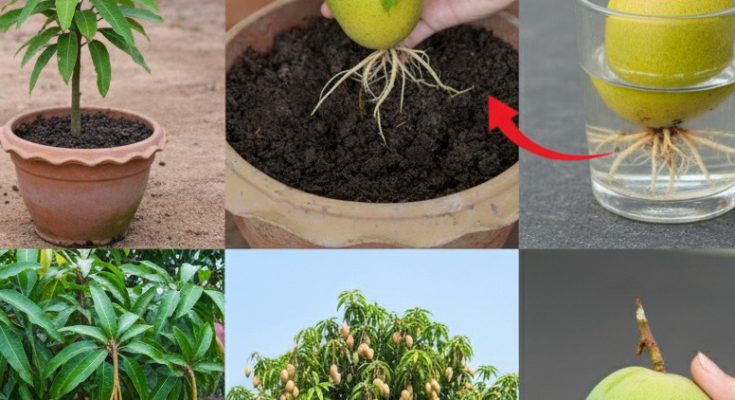This guide will walk you through everything you need to know to grow a mango tree from seed or sapling, care for it, and eventually enjoy its delicious fruits.
Why Grow a Mango Tree?
Mango trees are not only valuable for their tasty fruit but also offer shade, add aesthetic appeal to your garden, and provide habitat for birds and beneficial insects. Mangoes are rich in vitamins A and C, antioxidants, and dietary fiber, making them a nutritious addition to your diet.
Growing your own mango tree also means you get pesticide-free, fresh fruits without relying on store-bought options.
Choosing the Right Mango Variety
There are many mango varieties, each with unique fruit characteristics, size, and climate preferences. Some popular varieties include:
-
-
Alphonso: Known for its rich sweetness and aroma.
-
Kent: Large, juicy fruit with minimal fiber.
-
-
Tommy Atkins: Widely grown commercial variety, good shelf life.
-
Haden: Classic variety with vibrant color and rich flavor.
Choose a variety that is suited to your local climate and soil conditions for best results.
Starting Your Mango Tree: From Seed or Sapling?
You can grow mango trees either from seeds or by planting young grafted saplings.
-
From Seed: Growing mango from seed is inexpensive and satisfying but takes longer to bear fruit (usually 5-8 years). Seeds can be taken from fresh, ripe mangoes.
-
From Sapling: Purchasing a grafted mango sapling from a nursery will give you a head start, with fruit production starting in 2-4 years.
How to Grow Mango Trees from Seed
If you choose to grow from seed, here’s the step-by-step process:
-
-
Remove the Seed: Cut the mango fruit carefully and remove the large seed inside the pit. Clean off any remaining fruit pulp.
-
Extract the Seed Kernel: Carefully remove the hard outer shell to reveal the seed kernel inside (this is what you will plant).
-
-
-
Soak the Seed: Soak the seed kernel in water for 24 hours to encourage germination.
-
Plant the Seed: Fill a pot or seed tray with well-draining potting mix. Plant the seed about 1 inch deep with the convex side facing down.
-
Provide Warmth and Moisture: Place the pot in a warm, sunny spot. Keep the soil moist but not waterlogged.
-
-
Germination: Seeds usually sprout within 2-4 weeks. Once the seedling grows a few inches tall, transplant it into a larger pot or outdoors when conditions allow.
Selecting the Right Location for Your Mango Tree
Mango trees thrive in warm climates with plenty of sunshine. When planting outdoors, choose a location that offers:
-
-
Full Sun: At least 6-8 hours of direct sunlight daily.
-
Well-Draining Soil: Mango trees dislike waterlogged soil; sandy or loamy soil is ideal.
-
Space to Grow: Mango trees can grow very large—up to 30-40 feet or more—so ensure plenty of room for roots and canopy expansion.
-
If space is limited, growing mango trees in large containers is possible, though they may produce smaller fruit.
Planting Your Mango Tree
Whether planting a seedling or sapling:
-
-
Dig a hole twice the size of the root ball.
-
Place the tree in the hole, making sure the graft union (if present) is above the soil level.
-
-
Backfill the hole with soil and water deeply to settle the roots.
-
Apply mulch around the base to retain moisture and suppress weeds.
Caring for Your Mango Tree
Proper care is essential for healthy growth and fruit production.
-
-
Watering: Water young trees regularly to keep soil moist but avoid waterlogging. Mature mango trees are drought-tolerant but benefit from deep watering during flowering and fruiting seasons.
-
Fertilizing: Apply a balanced fertilizer 2-3 times a year. Nitrogen, phosphorus, and potassium are important for growth and fruiting.
-
-
-
Pruning: Prune the tree annually to remove dead or crossing branches and shape the canopy. Pruning helps improve air circulation and sunlight penetration.
-
Pest Control: Watch for common pests such as aphids, scales, and mealybugs. Use organic insecticides or neem oil if needed.
-
Disease Management: Mango trees can be affected by powdery mildew, anthracnose, and root rot. Proper pruning, sanitation, and fungicide applications help prevent diseases.
-
Harvesting Mangoes
Mangoes typically take 3-6 months to mature after flowering, depending on the variety. Fruits are ready to harvest when they develop full color, soften slightly, and emit a sweet aroma.
To harvest, gently twist or cut the fruit from the stem. Avoid pulling hard to prevent damage.
Growing Mango Trees Indoors or in Containers
If you don’t have outdoor space or live in cooler climates, growing mango trees indoors or in containers is possible:
-
-
Use large pots with good drainage.
-
Position the pot in a bright, warm location with plenty of sunlight.
-
Water moderately and fertilize monthly during the growing season.
-
-
Protect the tree from cold drafts and frost.
Though fruiting may be limited indoors, container mango trees make beautiful ornamental plants.
Final Tips for Successful Mango Growing
-
-
Mango trees need patience: fruit production can take several years.
-
Keep young trees well-watered and mulched to encourage strong roots.
-
Regularly inspect for pests and diseases.
-
-
Harvest fruits carefully to avoid damaging the tree.
-
Consider grafted saplings for quicker fruit production and consistent quality.
Growing a mango tree is a fulfilling gardening project that rewards you with delicious fruits and lush greenery. Whether you start from seed or sapling, following these steps and providing attentive care will ensure your mango tree thrives for years to come.
Enjoy the sweet taste of homegrown mangoes and the beauty of your very own mango tree!
